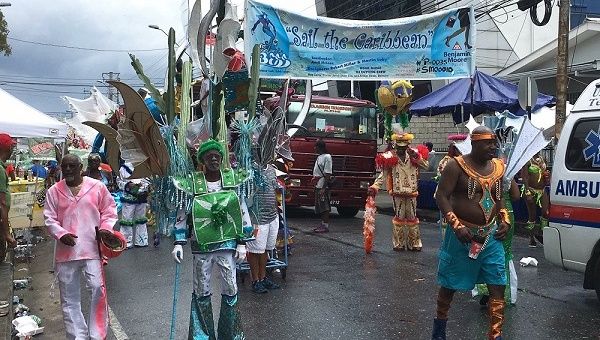The Roots of Resistance and the Resilience of the Caribbean Carnival
This was another of the Psychology of Carnival Series I did for teleSUR English. Hoping to find all four. Will include the Wayback Machine Link to the original here. Some notes to consider I now spell the festival as Kambule, which is from the Kikongo word for procession. The old understanding was that it evolved from canne brules the patwa for burning cane hence Canboulay. Which is the etomology I understood in 2017 when this was first published.
The article is included below with an original photo from Naasira Mohammed.

The annual festival was used as a form of resistance to colonialism and a way to challenge the status quo.
The Trinidad and Tobago Carnival, which is the model for the Caribbean-style Carnivals seen across the region and around the world has its birth in resistance and rebellion. In Trinidad, the Carnival was the place where one could indulge in behaviour normally frowned upon. And it was in this atmosphere that the Carnival specific love of mockery and satire developed. Through costume and song, participants began to use Carnival as the time and place to challenge the status quo, and the society learned to accept the criticism, sometimes begrudgingly, which they might have resisted if done in a another form and place.
The word Carnival means farewell to the flesh. The French settlers in Trinidad would engage in masquerade balls, where some would dress up as slaves and engage in scandalous behaviour only tolerated in the weeks and days leading up to Lent, the Catholic 40 days of fasting and religious penance.
Their slaves had masking traditions that they engaged in as well. And while the French slave owners were mocking their chattel, their chattel found ways to parody them in return. One Carnival portrayal that was suppressed because it was deemed too offensive was that of the Pissenlit. The late cultural anthropologist Daniel J. Crowley says the name means “wet the bed” and the depiction was a pointed commentary on the poor hygiene of the planter class.
Even the music of the Carnival is rooted in resisting the norm. In David Rudder’s song Calypso, he describes it as “a living vibration, rooted deep within my Caribbean belly. Lyrics to make a politician cringe, or turn a woman’s body into jelly.” While it may be possible to trace the history of many a Caribbean isle through its music, one can certainly trace periods of civil unrest and political malfeasance in its music. From The Black Stalin’s “Bun Dem” to the Mighty Chalkdust’s “Learn From Arithmetic”, calypsonians’ work as the voice of the people holding the authorities in check is a throwback to the standard set by the “first” calypsonian Gros Jean. He was a slave, his master’s favourite. He was also a singer of the most lewd songs where he’d mock his master, pointing out his failings to an appreciative audience, including his master who, it’s said, laughed the loudest at the things said at his expense.
And the dance of the Carnival, the wine, has been described by the dancer and academic Sonia Dumas as as “either a rotation, a gyration or an osculation of the pelvic region, usually done in rhythmic style to music in a festive or recreational environment”. Even in dance Caribbean people are resisting colonial standards of what is good and proper behaviour. In her TedEx talk on the subject, Dumas says in the Caribbean, the hip is the weapon against subjugation. The hip being the body part that is most prominently displayed in wining, and in all aspects of Carnival. As an act, wining is resistance and resilience in dance. She says, “The hip is what enjoins us to say we’re fighting back. We’re fighting for our freedom, we’re going to be what we can be. We’re going to be the best us that we can be, and we’re showing it through our hips.”
In Trinidad, pre and immediately post-Emancipation day August 1st, 1838, Carnival wasn’t simply a pre-Lenten event. Carnival-like activities also took place when the slaves and former slaves celebrated. When the Emancipation proclamation was read out there was mas (celebration) in the streets. It was a Carnival celebration, outside of the pre-Lenten timetable it currently holds in Trinidad and Tobago.
However, because of this celebration, this freedom to dress, sing and dance in ways that expressed dissatisfaction with the powers that be, and the society at large, was a worry to the local authorities. And in 1881 they were empowered to try and stop the Carnival. But their attempts failed as the people organised their respective communities under a champion stick fighter named Joe Talmana, and armed with flambeau and bwa (hard wooden sticks used as weapons) resisted the colonial police force lead by Captain Baker. Cultural researcher Lennox Pierre interviewed an eyewitness to the riot, what is now known as the Canboulay Riot, in 1954. She said the people “swept the ground with the police” forcing their retreat and securing both an apology from the governor and the right to have their Carnival.
Much of the ancient elements of Carnival are still evident in Trinidad, and in London’s Notting Hill, and New York’s Labour Day. In 2017, masqueraders in London are resisting gentrification in North Kensington, site of June’s Grenfell Tower Fire, which killed many of their loved ones. The Tory-lead council has been accused of the gross neglect over the blaze, and of trying to use it to move longstanding black and brown residents from the area.
In New York masqueraders are also fighting limits to their street parade, They are also acutely aware that their multi-cultural street party may have a growing significance in the United States where racism seems more visible than it has in years past because of the implicit, or explicit support of their current president.